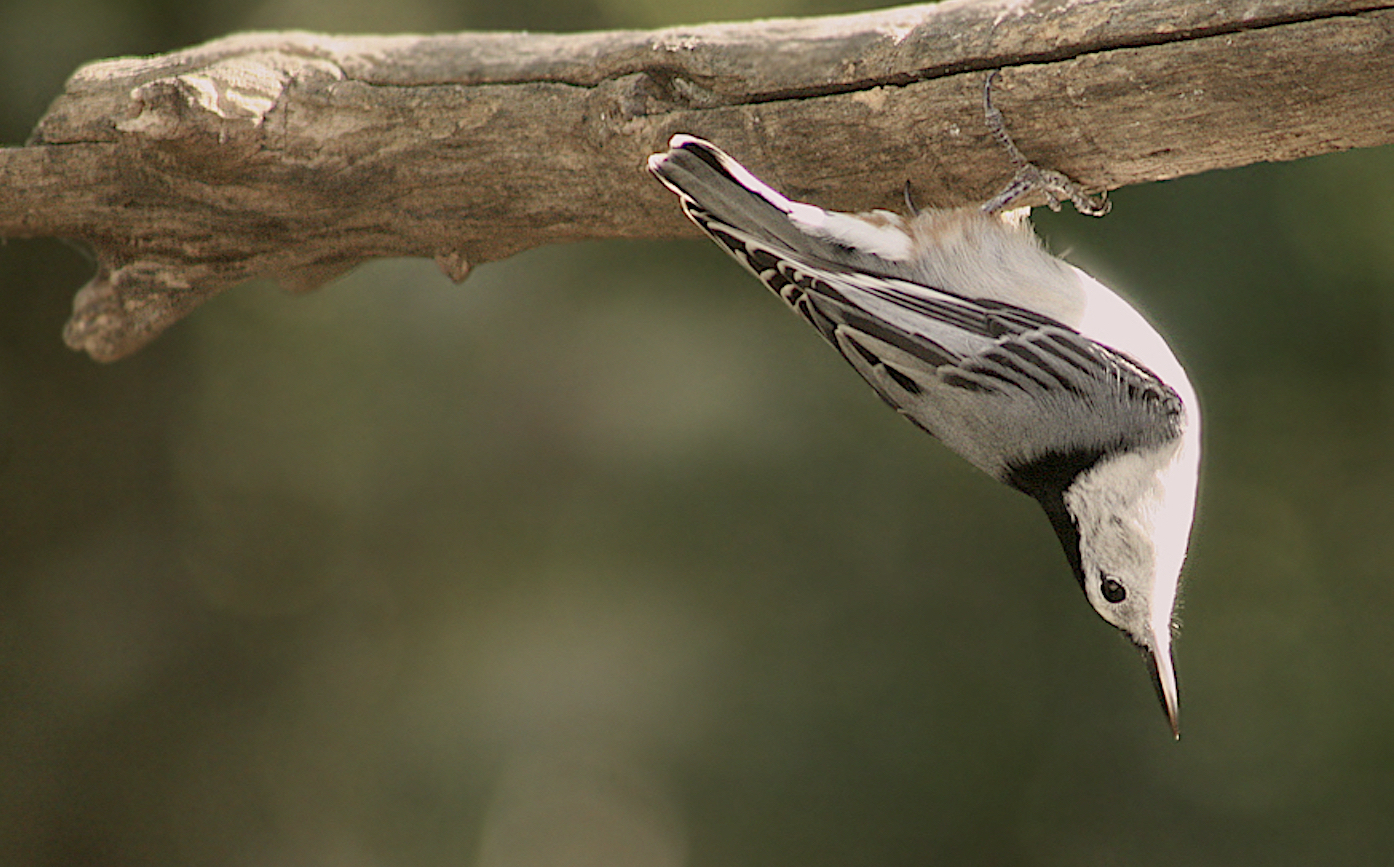BY KIERAN LINDSEY, PhD

 Watching a white-breasted nuthatch (Sitta carolinensis) cascade along the steep slope of a tree brought to mind the playground at Oakville Elementary, and made me wonder if the species’ iconic bottoms-up foraging style is the result of a dare.
Watching a white-breasted nuthatch (Sitta carolinensis) cascade along the steep slope of a tree brought to mind the playground at Oakville Elementary, and made me wonder if the species’ iconic bottoms-up foraging style is the result of a dare.
The far corner of our grade school property was the site of many childhood rites of passage. The first test of growing maturity during my free-range youth was mustering enough courage to climb all the way to the top of the seven-foot stainless steel slide. Once you set sweaty hands and sneaker-shod feet on the slippery round rungs there was only one acceptable way back to terra firm… and don’t tarry at the top while your short life flashes by, please, because there’s a stack of impatient kids on the ladder behind you.
After you survived that descent so many times the stunt became mundane for you and your age cohort, the pressure was on to up the thrill-and-status ante by switching from the standard seated position to the hazardous belly-flop. If you managed to avoid a face full of sharp limestone mining rubble at the end of a skid down that hot metal chute, it was on to the monkey bars, where your friends and frenemies would badger you and each other to hang by the knees until you got a head-rush, or a concussion, or heard the blessed end-of-recess bell.
Even in the age of helicopter-adults, I’ve noticed that kids still spend a lot of time upended, either of their own volition (albeit often coerced) or as the unwitting source of entertainment for older relatives at family gatherings. It’s an odd behavioral quirk given that, unlike the nuthatch, upside-down is not the Homo sapiens’ default posture.
Compare our feeble limbs and equilibrium to a bird with such strong toes and steadfast balance it can sprint down the vertical trunk of a towering hickory.
Admittedly, the white-breasted nuthatch has some other advantages over humans when it comes to repelling without a rope. Gravity is an equal opportunity force but it definitely feels kinder to those who are light on their feet (0.6—1.1 oz or 18—30 g) and who cling close to the vertical surface they’re traversing. True, nuthatches don’t have hands so they’re limited to two points of contact instead of four, but if they start to lose altitude too quickly they can always spread those slate-gray wings, flutter up to the crown of a large deciduous tree (unlike all other North American nuthatches, who prefer pines), and start their foraging efforts over again.
The nuthatch’s ability to flip it’s perspective on the world is a legitimate advantage when shopping for groceries. Navigating timber head-first provides access to a nourishment niche; white-breasted nuthatches and their kin can find adult insects, larvae, and eggs that are harder to see when viewed from below and, therefore, are less likely to be discovered and consumed by someone else.

That said, this mostly non-migratory species is omnivorous so in winter, when six-legged food becomes scarce, it switches from insectivore to granivore. You wouldn’t think it necessary to pull out the gymnastic moves when sustenance is as visible and stationary as a seed, but the nuthatch’s agility makes it easier to reach beneath twigs and branches, or to go out on a limb.
Oddly enough, the inspiration for this topsy-turvy birdy’s common name isn’t acrobatics; it’s their table manners. “Nuthatch” comes from the Middle English notehache (note for nut + hache from Old English tohaccian, to hack). When members of the nuthatch family — and there are 29 different species of the Sitta genus spread across the Northern Hemisphere — find an acorn, chestnut, or a large, hard-shelled beetle, they’ll jam it into a wrinkle or crack in tree bark, then chip their way in with that sharp chisel beak… often while inverted, of course.

Nuthatches don’t spend all of their life hanging from their toes but they must enjoy that position above all the rest because even when it isn’t necessary to be capsized, as when visiting a feeder for a suet snack, their favorite angle of attack appears to be 180 degrees. If we’re honest about it, I think people can relate. From our disorienting entry into the world as an infant, to daunting childhood dares, and then the roller-coaster ride of adult life, once the challenge has been accepted to turn the world on its head who can deny that it’s fun to defy gravity?


